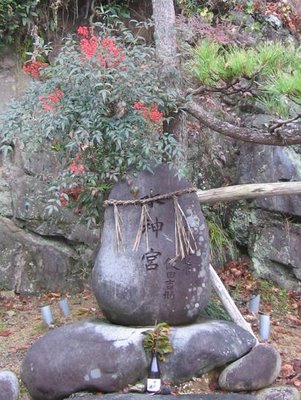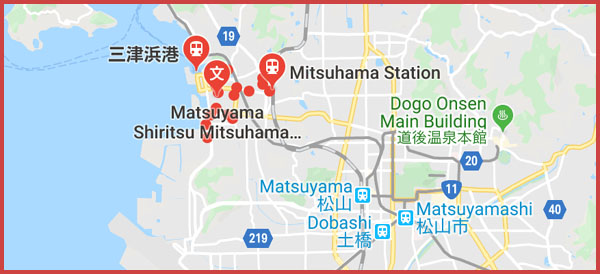https://japanshrinestemples.blogspot.com/2019/06/ido-no-kami-well-legends.html
[ . BACK to DARUMA MUSEUM TOP . ]
. Shinto Shrines (jinja 神社) - Introduction .
. kami 神 Shinto deities .
:::::::::::::::::::::::::::::::::::::::::::::::::::::::::::::::::::::::::::::::::::::::::::::::::::::::::::::::::::::::::::::::::::::::::::::::::::::::::::::::::::::::::::::::::::::
Ido no Kami 井戸の神 / Idogami 井戸神 Deity of the Well
Another name for the
. Mizu no Kami, Mizunokami 水の神 Deity of Water .
水神様 / スイジンサマ Suijin Sama

venerated in Katsuyama, Okayama
.......................................................................
furui no kami 井戸の神, furui kami, furuikami 古井神 Deity of the old well

source : ameblo.jp/takenichi...
..............................................................................................................................................
Shrine 御井神社 Mii Jinja "the honorable well"
2518 Hikawacho Naoe, Izumo, Shimane / 斐川町

- quote -
Okuninushi and the Rabbit
..... in Hikawa is Mii Shrine, which has three wells on its grounds
that are said to have been used by Yagami-hime when she gave birth to the child she had with Okuninushi.
- source : japanesemythology... -
.......................................................................
井戸の神聖化 - wikipedia
..............................................................................................................................................
. sarashi i, sarashi-i . 晒井 さらしい cleaning the well .
well-cleaning, i zarai 井浚(いざらい)
ido zarai 井戸浚, 井戸浚い(いどざらい)
ido gae 井戸替(いどがえ)"changeing the well"
- idohori shi 井戸堀師 digging a well or making a new well

idobata kaigi 井戸端会議 debates (gossip) at the well
Women used to come to the village wells and designated places along rivers to do the laundry and the mental laundry (gossip)。
..............................................................................................................................................
- - - The Kappa is often seen as Mizunokami, Suijin
. suijin 水神 河童 Kappa as a water deity .
and Kappa Jinja 河童神社 Kappa Shinto Shrines
:::::::::::::::::::::::::::::::::::::::::::::::::::::::::::::::::::::::::::::::::::::::::::::::::::::::::::::::::::::::::::::::::::::::::::::::::::::::::::::::::::::::::::::::::::::
- Reference : 井戸の神
. Shrine, Shinto Shrine (jinja 神社) - Introduction .
. kami 神 Shinto deities - ABC-LIST - .
:::::::::::::::::::::::::::::::::::::::::::::::::::::::::::::::::::::::::::::::::::::::::::::::::::::::::::::::::::::::::::::::::::::::::::::::::::::::::::::::::::::::::::::::::::::
- - - - - H A I K U - - - - -
井戸神の遠くに見ゆる雑煮かな
Idogami no tooku ni miyuru zooni kana
斎藤夏風 Saito Kafu
雪明りして井戸神の鏡餅
yuki akari shite Idogami no kagami mochi
赤石明子 Akashi Akiko

source : fujiclean.co.jp/fujiclean/water...
:::::::::::::::::::::::::::::::::::::::::::::::::::::::::::::::::::::::::::::::::::::::::::::::::::::::::::::::::::::::::::::::::::::::::::::::::::::::::::::::::::::::::::::::::::::
. kawaya no kami 厠の神 God of the Toilet .
厠神 Benjogami / Kookagami 後架神 Kokagami
The God of the Toilet is the Elder Sister,
The God of the Well, Shinzui san シンズイさん is the younger sister.
At the bottom of the Well fro Shinzui zanthere are three stones.
This deity does not like metal things. If something made of metal falls into the well and is not taken out very soon, people have to abandon this well and make a new one. If they do not, family members will get ganbyoo 眼病 eye disease.
. Legends about eye diseases .
:::::::::::::::::::::::::::::::::::::::::::::::::::::::::::::::::::::::::::::::::::::::::::::::::::::::::::::::::::::::::::::::::::::::::::::::::::::::::::::::::::::::::::::::::::::
. Legends and Tales from Japan 伝説 - Introduction .
....................................................................... Aichi 愛知県 .....
.......................................................................
豊田市 Toyota city 岩倉町 Iwakura town
Idogami sama 井戸神様
In 1881, a family had a performance in the home and then put a cover on the well for everybody to walk over. But this caused a curse of Idogami sama 井戸神様.
The mother of the family got crazy and begun to perform all day long. Grandmother had a toxic disease and when Grandfather went to 観音様 Kannon Sama to pray for her health, she felt better.
....................................................................... Fukuoka 福岡県 .....
. Suijin sama スイジンサマ, the Kappa Water Deity .
The Idogami 井戸神 God of the Well is also called Suijin Sama.
....................................................................... Hyogo 兵庫県 .....
.......................................................................
姫路市 Himeji city 飾磨郡 Shikama district
If someone places a knife on the kama 竈 hearth, Ido no Kamisama 井戸の神様 begins to cry.
. kama, kamado 竈 Legends about the kitchen hearth .
....................................................................... Ibaraki 茨城県 .....
.......................................................................
行方郡 Namegata district 麻生町 Aso town
. Setsubun - oni wa soto 鬼は外 "Demons, get out!" .
On the day of Setsubun 節分 the Seasonal Divide people make special offerings, especially of hiiragi柊 a holly branch and put them on butsudan 仏壇 the Buddhist family altar, the kamidana 神棚 shelf of the Gods, for the 井戸の神 Ido no Kami and other places to make sure, the demons do not come in.
The offerings of iwashi イワシ are eaten by fuku no kami 福の神 the God of Good Luck.
. oni to hiiragi 鬼と柊 Demon and the Holly branch .
. fuku no kami 福の神 God of Good Luck .
....................................................................... Kagawa 香川県 .....
.......................................................................
三豊郡 Mitoyo district 詫間町 Takuma town
Before filling in an old well, there must be a purification ritual performed.
To make sure the Ido no Kami san 井戸の神さん can come back any time, there must be a bamboo pole in the ground. Ido no Kami can then slip through this pole and come and go as he pleases.
....................................................................... Kagoshima 鹿児島県 .....
.......................................................................
薩摩郡 Satsuma district 東郷町 Togo town
After a new well is made, there must be an offering of nasu 茄子 eggplants.
If this is not done, the Mizunokami will leave his tooth bite visible.
....................................................................... Kyoto 京都府 .....
.......................................................................
福知山市 Fukuchiyama city
If people stay too long near the well and talk and talk . . . the Ido no kami 井戸ノ神 gets angry and disappears.
....................................................................... Nagasaki 長崎県 .....
.......................................................................
西海市 Saikai city 西彼町 Seihi town
Ido no Kami is the same as 水神 Mizugami.
If someone in the family gets ill, Mizugami must be angry.
Making offerings of miki お神酒 ritual rice wine, shio 塩 salt and kome 米 rice grains will cure the person.
....................................................................... Wakayama 和歌山県 .....
.......................................................................
有田郡 Arida district 金屋町 Kanaya town
Ido no Kamisama is Suijin san 水神さん.
Once an old woman became a strong headache. A healer told her that she had not been respectful to Suijin san 水神さん.
She began to say her prayers regularly and was soon healed.
..............................................................................................................................................
- reference : nichibun yokai database -
井戸神 / 井戸の神 / イドガミ / 井戸ノ神 - ok
:::::::::::::::::::::::::::::::::::::::::::::::::::::::::::::::::::::::::::::::::::::::::::::::::::::::::::::::::::::::::::::::::::::::::::::::::::::::::::::::::::::::::::::::::::::
[ . BACK to DARUMA MUSEUM TOP . ]
[ . BACK to WORLDKIGO . TOP . ]
- #idookami #welldeity #suijin #mizunokami -
:::::::::::::::::::::::::::::::::::::::::::::::::::::::::::::::::::::::::::::::::::::::::::::::::::::::::::::::::::::::::::::::::::::::::::::::::::::::::::::::::::::::::::::::::::::
Ido no Kami well legends
. Shinto Shrines (jinja 神社) - Introduction .
. kami 神 Shinto deities .
:::::::::::::::::::::::::::::::::::::::::::::::::::::::::::::::::::::::::::::::::::::::::::::::::::::::::::::::::::::::::::::::::::::::::::::::::::::::::::::::::::::::::::::::::::::
Ido no Kami 井戸の神 / Idogami 井戸神 Deity of the Well
Another name for the
. Mizu no Kami, Mizunokami 水の神 Deity of Water .
水神様 / スイジンサマ Suijin Sama

venerated in Katsuyama, Okayama
.......................................................................
furui no kami 井戸の神, furui kami, furuikami 古井神 Deity of the old well

source : ameblo.jp/takenichi...
..............................................................................................................................................
Shrine 御井神社 Mii Jinja "the honorable well"
2518 Hikawacho Naoe, Izumo, Shimane / 斐川町

- quote -
Okuninushi and the Rabbit
..... in Hikawa is Mii Shrine, which has three wells on its grounds
that are said to have been used by Yagami-hime when she gave birth to the child she had with Okuninushi.
- source : japanesemythology... -
.......................................................................
井戸の神聖化 - wikipedia
..............................................................................................................................................
. sarashi i, sarashi-i . 晒井 さらしい cleaning the well .
well-cleaning, i zarai 井浚(いざらい)
ido zarai 井戸浚, 井戸浚い(いどざらい)
ido gae 井戸替(いどがえ)"changeing the well"
- idohori shi 井戸堀師 digging a well or making a new well

idobata kaigi 井戸端会議 debates (gossip) at the well
Women used to come to the village wells and designated places along rivers to do the laundry and the mental laundry (gossip)。
..............................................................................................................................................
- - - The Kappa is often seen as Mizunokami, Suijin
. suijin 水神 河童 Kappa as a water deity .
and Kappa Jinja 河童神社 Kappa Shinto Shrines
:::::::::::::::::::::::::::::::::::::::::::::::::::::::::::::::::::::::::::::::::::::::::::::::::::::::::::::::::::::::::::::::::::::::::::::::::::::::::::::::::::::::::::::::::::::
- Reference : 井戸の神
. Shrine, Shinto Shrine (jinja 神社) - Introduction .
. kami 神 Shinto deities - ABC-LIST - .
:::::::::::::::::::::::::::::::::::::::::::::::::::::::::::::::::::::::::::::::::::::::::::::::::::::::::::::::::::::::::::::::::::::::::::::::::::::::::::::::::::::::::::::::::::::
- - - - - H A I K U - - - - -
井戸神の遠くに見ゆる雑煮かな
Idogami no tooku ni miyuru zooni kana
斎藤夏風 Saito Kafu
雪明りして井戸神の鏡餅
yuki akari shite Idogami no kagami mochi
赤石明子 Akashi Akiko

source : fujiclean.co.jp/fujiclean/water...
:::::::::::::::::::::::::::::::::::::::::::::::::::::::::::::::::::::::::::::::::::::::::::::::::::::::::::::::::::::::::::::::::::::::::::::::::::::::::::::::::::::::::::::::::::::
. kawaya no kami 厠の神 God of the Toilet .
厠神 Benjogami / Kookagami 後架神 Kokagami
The God of the Toilet is the Elder Sister,
The God of the Well, Shinzui san シンズイさん is the younger sister.
At the bottom of the Well fro Shinzui zanthere are three stones.
This deity does not like metal things. If something made of metal falls into the well and is not taken out very soon, people have to abandon this well and make a new one. If they do not, family members will get ganbyoo 眼病 eye disease.
. Legends about eye diseases .
:::::::::::::::::::::::::::::::::::::::::::::::::::::::::::::::::::::::::::::::::::::::::::::::::::::::::::::::::::::::::::::::::::::::::::::::::::::::::::::::::::::::::::::::::::::
. Legends and Tales from Japan 伝説 - Introduction .
....................................................................... Aichi 愛知県 .....
.......................................................................
豊田市 Toyota city 岩倉町 Iwakura town
Idogami sama 井戸神様
In 1881, a family had a performance in the home and then put a cover on the well for everybody to walk over. But this caused a curse of Idogami sama 井戸神様.
The mother of the family got crazy and begun to perform all day long. Grandmother had a toxic disease and when Grandfather went to 観音様 Kannon Sama to pray for her health, she felt better.
....................................................................... Fukuoka 福岡県 .....
. Suijin sama スイジンサマ, the Kappa Water Deity .
The Idogami 井戸神 God of the Well is also called Suijin Sama.
....................................................................... Hyogo 兵庫県 .....
.......................................................................
姫路市 Himeji city 飾磨郡 Shikama district
If someone places a knife on the kama 竈 hearth, Ido no Kamisama 井戸の神様 begins to cry.
. kama, kamado 竈 Legends about the kitchen hearth .
....................................................................... Ibaraki 茨城県 .....
.......................................................................
行方郡 Namegata district 麻生町 Aso town
. Setsubun - oni wa soto 鬼は外 "Demons, get out!" .
On the day of Setsubun 節分 the Seasonal Divide people make special offerings, especially of hiiragi柊 a holly branch and put them on butsudan 仏壇 the Buddhist family altar, the kamidana 神棚 shelf of the Gods, for the 井戸の神 Ido no Kami and other places to make sure, the demons do not come in.
The offerings of iwashi イワシ are eaten by fuku no kami 福の神 the God of Good Luck.
. oni to hiiragi 鬼と柊 Demon and the Holly branch .
. fuku no kami 福の神 God of Good Luck .
....................................................................... Kagawa 香川県 .....
.......................................................................
三豊郡 Mitoyo district 詫間町 Takuma town
Before filling in an old well, there must be a purification ritual performed.
To make sure the Ido no Kami san 井戸の神さん can come back any time, there must be a bamboo pole in the ground. Ido no Kami can then slip through this pole and come and go as he pleases.
....................................................................... Kagoshima 鹿児島県 .....
.......................................................................
薩摩郡 Satsuma district 東郷町 Togo town
After a new well is made, there must be an offering of nasu 茄子 eggplants.
If this is not done, the Mizunokami will leave his tooth bite visible.
....................................................................... Kyoto 京都府 .....
.......................................................................
福知山市 Fukuchiyama city
If people stay too long near the well and talk and talk . . . the Ido no kami 井戸ノ神 gets angry and disappears.
....................................................................... Nagasaki 長崎県 .....
.......................................................................
西海市 Saikai city 西彼町 Seihi town
Ido no Kami is the same as 水神 Mizugami.
If someone in the family gets ill, Mizugami must be angry.
Making offerings of miki お神酒 ritual rice wine, shio 塩 salt and kome 米 rice grains will cure the person.
....................................................................... Wakayama 和歌山県 .....
.......................................................................
有田郡 Arida district 金屋町 Kanaya town
Ido no Kamisama is Suijin san 水神さん.
Once an old woman became a strong headache. A healer told her that she had not been respectful to Suijin san 水神さん.
She began to say her prayers regularly and was soon healed.
..............................................................................................................................................
- reference : nichibun yokai database -
井戸神 / 井戸の神 / イドガミ / 井戸ノ神 - ok
:::::::::::::::::::::::::::::::::::::::::::::::::::::::::::::::::::::::::::::::::::::::::::::::::::::::::::::::::::::::::::::::::::::::::::::::::::::::::::::::::::::::::::::::::::::
[ . BACK to DARUMA MUSEUM TOP . ]
[ . BACK to WORLDKIGO . TOP . ]
- #idookami #welldeity #suijin #mizunokami -
:::::::::::::::::::::::::::::::::::::::::::::::::::::::::::::::::::::::::::::::::::::::::::::::::::::::::::::::::::::::::::::::::::::::::::::::::::::::::::::::::::::::::::::::::::::























